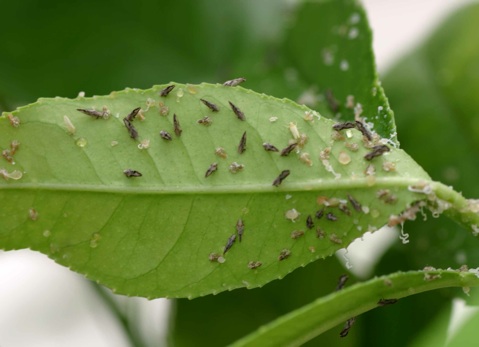Psyllid Poison Meeting Announced for Tuesday
Tree and Soil Treatments Planned to Combat Asian Citrus Psyllid Infestations

An informational discussion about the upcoming spraying for Asian citrus psyllids has been scheduled at the Ramada at Turnpike and Calle Real for Tuesday, January 19, 5:30-7 p.m. The breeding population of citrus psyllids has grown to the extent that they are showing up more frequently in traps, said Dr. Heather Scheck of the County Agricultural office. The state and county program will be spraying an insecticide from the ground and applying a soil poison on 48 hours notice to property owners. The program is voluntary, said Scheck, and those noticed can refuse by checking a box on the notice or phoning the agency. The state pest hotline is (800) 491-1899.
In the state notice for the program, officials said no biological, cultural, or physical controls exist to fight the psyllids, which can carry a bacteria that has decimated Florida’s orange and lemon orchards. The bugs found in Santa Barbara have so far been clean of the Huanglongbing (HLB) bacteria, though HLB was found at Santa Barbara’s airport on tangelos from Florida by county entomologist Dr. Brian Cabrera last January. HLB was found in San Gabriel last summer, and the trees were removed. Fruit infected with the bacteria fail to mature — HLB is also called citrus greening disease — and the trees eventually die.
In areas within 400-800 meters of each infestation site, according to the notice, cyfluthrin, a contact insecticide of the pyrethrin family, will be sprayed directly onto the foliage of host plants. The program will also apply imidacloprid, to kill immature psyllids, to the soil beneath the plants.
Imidacloprid is a neonicotinoid poison that the Environmental Protection Agency (EPA) has found to be of risk to bees, reported Mother Jones earlier this month, and potentially to bee colonies, when applied to the soil and to plant leaves. The EPA report found “potential” for risk to colonies through nectar and pollen because it only had a study of application post-bloom; it notes the label instructions allow application before and during bloom. Todd Bebb, a longtime beekeeper and among the founders of the Santa Barbara Beekeepers Association, stated of the program, “If CDFA [California Department of Food and Agriculture] has read the EPA’s latest report in the reevaluation of imidacloprid and still insists on poisoning all of us, we need a new CDFA, EPA, and CA DPR [California Department of Pesticide Regulation].”
Psyllids have been found in Carpinteria, Santa Barbara, Goleta, and Solvang. Maps of the spray locations can be found here.
Related Stories
Nasty Bug Appears as County Slashes Top Pest, Plant Jobs
Citrus Psyllid Predator Released in County
‘Neonic’ Poison Found Throughout City
Beekeepers Cry Foul over Pesticide Spray



